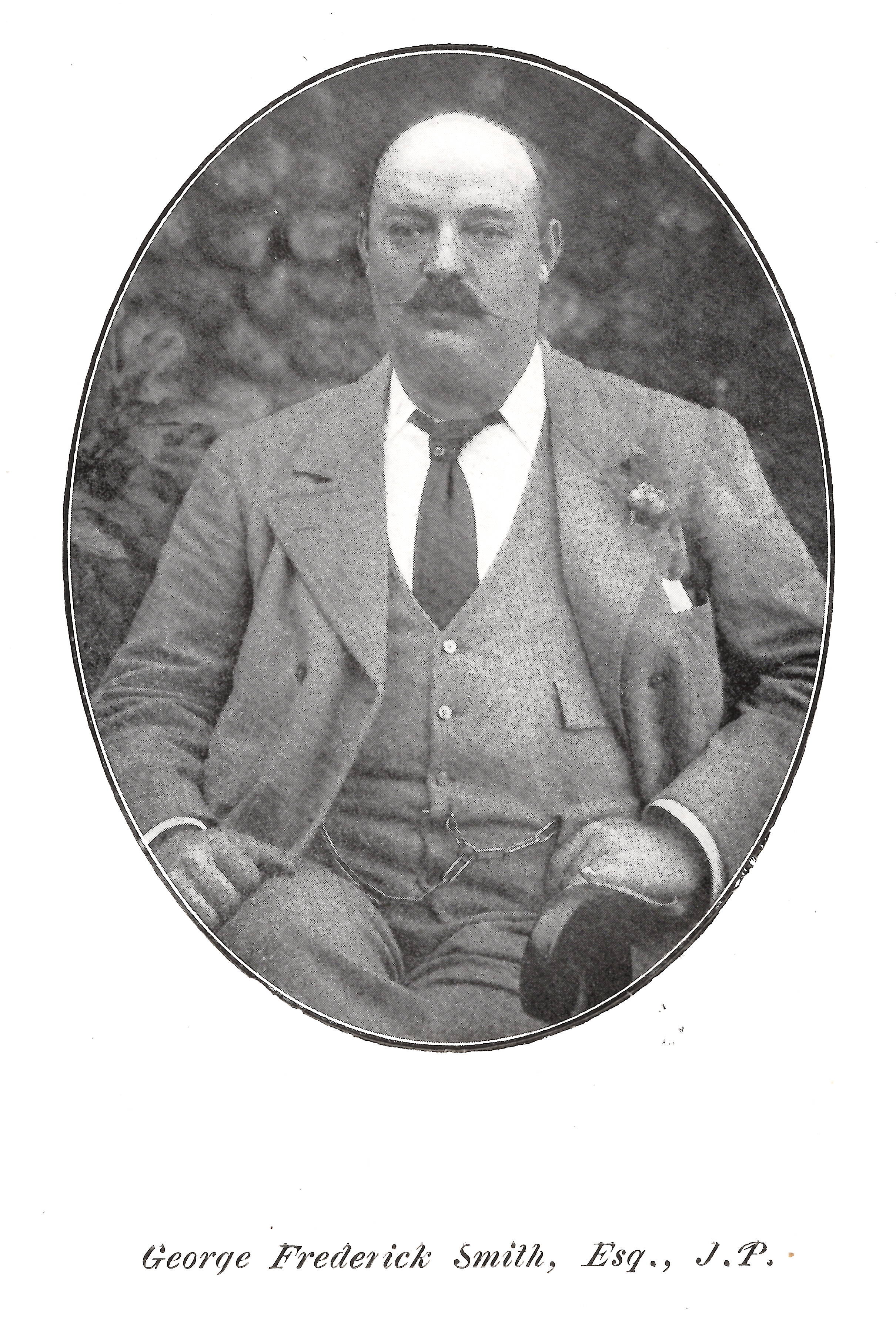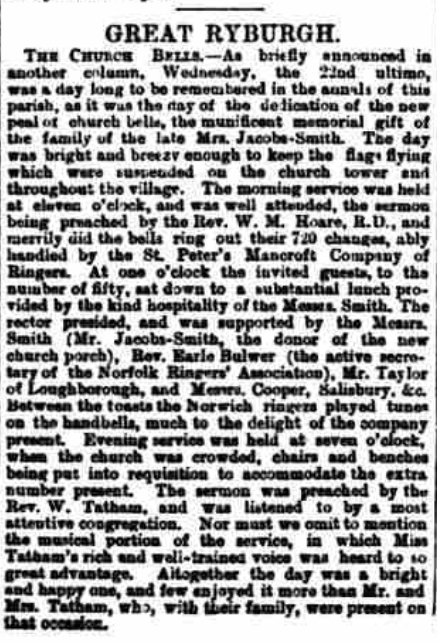The Bells at Great Ryburgh (part 1.)
Thus far, the earliest mention found of bells at Ryburgh is 1503.—In the Will of Richard Harneyse, of Great Ryburgh:
Bequests to the high altar in the church of St. Andrew there, and to St. Thomas's light, St. John's light, and Our Lady's light [in the same church]. Also to St. Erasmus' Gild in Fulmerston, to the Freers in Walsyngham, to poor householders in Ryburgh, Gild brethren and sisters, to priests &c. for dirges, "to every child that can say De profundis ld.," for a light before Our Lady in Ryburgh church, &c. To Emma his wife, his place in Ryburgh, &c. To Robert his son, 40s. Other children mentioned. Sir Geffrey Howes, vicar of Little Ryburgh, and others to be executors. Moneys for repair of the leading of the church and bells.
(NRO ref: NCC Will Register. Popy, 384)
.
The inventory of Edward VI in 1552 lists Ryburgh as having “1 stepelle belle wayeng by estimacon 5 c(wts)” as well as “2 hand belles, a sacryn bell and a sancts belle” all weighing around 20lbs or less.
“Thereof assigned to be occupied and used in the ministracon of devine service the said belle of 5 cwts.” (F.H.Tatham “ Great Ryburgh” 1947)
In his Church notes of 1758 Tom Martin writes:
“Riburgh Magna. Old steple Round at bottom & eight squared at the upper story. Tis built with rude Carr Stones & pebbles &c. Only one Bell” (NRO RYE MS 17/3)
In 1890 the present ring of 6 bells replaced a single bell with the inscription “Joseph Eayre, St Neots fecit 1771” This was sold for scrap to Great Ryburgh Farmers’ Foundry. (F.H.Tatham “ Great Ryburgh” 1947)
All the bells bear the stamp of John Taylor & Co. Loughborough and the date MDCCCXC. Recent researches at Taylor’s show that there was a near identical ring cast in the same year for the parish church at Lockerly in Hampshire, so we have a
twin!
The Tenor (12-0-16 in G) is inscribed:
TO THE GLORY OF GOD AND IN LOVING MEMORY OF OUR FATHER AND MOTHER.
THIS PEAL OF SIX BELLS WAS GIVEN BY
GEORGE FREDERICK SMITH,
FREDERICK EDGAR SMITH,
HERBERT EDGAR SMITH,
EDGAR SMITH,
ANNIE MARY SMITH,
EDITH SMITH,
HARRY JACOB SMITH
AND
CHARLES GEORGE SMITH.
MDCCCXC.

The negotiations for the purchase of the bells and their installation seems to have been handled by George Frederic Smith living at Wells who must have had contact with Taylors when they were hanging the new Octave at St Nicholas’. The estimate of September 10th 1890 (NRO MC 2019/37,908X3) gives the total projected finished weight as being 43 cwt.s
“and to be charged for at the rate of £5-7-10d. per cwt. Warranted cast of pure Copper and Tin as specified by Lord Grimthorpe.
Clappers, fittings, ropes, framework and fixing the whole complete in the tower- leaving the bells in first class ringing order-as per specification on page 19 of catalogue.
Carriage of all bells and materials about 6 tons at
£2 per ton.”
The cost of all this was £367 -7 – 4d.
A further Estimate for:
“Two English oak beams 14”x 9” and two 12”x 7” – nine 10” x 8” trimmers between them – including all requisite bolts, plates and nuts – Also 4 stone corbels to carry ends of two beams – the whole fixed complete in the tower including carriage,
£33 – 0 – 0d.”
A 3rd Estimate was for a “new floor under the beams, consisting of 11/2 inch grooved and tongued floor boards, resting upon 9” x 5” Pitch Pine beams – fixed complete in the tower,
£8 – 0 – 0d.
All materials and workmanship to be of the best quality of their several kinds- Terms 2.5% discount for cash within one month of completion”
Taylors in their letter accompanying the estimate also had this to say:
“ Our man further says that some repairs will be necessary to the lower floor on which the ringers will stand – but we do not understand what is wanted though we believe that not much is required”
The weights as recorded at Taylor’s in the job book for the period 1890-1894
as cast and as finished
4-0-10 Treble 4-0-3
4-2-7 2 4-2-3
5-1-25 3 5-1-19
6-3-14 4 6-3-6
8-3-23 5 8-3-10
12-0-18 Tenor 12-0-16
Two more letters tell, that although “ The bells are quite ready” on Dec 8th 1890, delays to the fixing have been encountered “owing to the serious illness of one of our leading bellhangers and other reasons for them being “ altogether behindhand” and promising to start “immediately after Christmas
Dec 30th1891
“Dear Sir, We have everything loaded on the drays ready for carting to the station but have kept them back on account of the weather –
It is scarcely fit for men to be at work in a Church tower during such severe frosts - We hope that there will be a change so that Smith may go to Ryburgh on Monday next”.
Having eventually got to Ryburgh and progressed well with the work, we have one last letter in which Taylor’s optimism for the state of the Ringing chamber floor proves to be ill founded:
Feb 4th 1891
“Dear Sir,
Our bellhanger ( S.Smith) has sent us particulars of the timber required for the floor on which the ringers will stand - the price for this will be £9 – 10. fixed complete – 2” floorboards grooved and tongued with hinged trap door – and joists 41/2” x 3” – Kindly let us know if we are to supply this? – We hope the work is going on to your satisfaction. Yours very truly John Taylor & Co.”
Although the floor was altered, (most probably when the new organ gallery was added in the restoration of 1910-1912) the now blocked trap door is still visible beneath the feet of the ringer of the 4th bell.
At 11.30 a.m. on Wednesday April 22nd 1891 the Service for the “Dedication of the Church Bells” was held. The school children attended the service and were give a “holiday” in the afternoon. ( School Log Book 1862-1902)
News of the bells reached the press in April 1891 and the following is to be found in Norfolk News on Saturday 22nd May 1891 reproduced by kind permission of the British Newspaper Archive:
